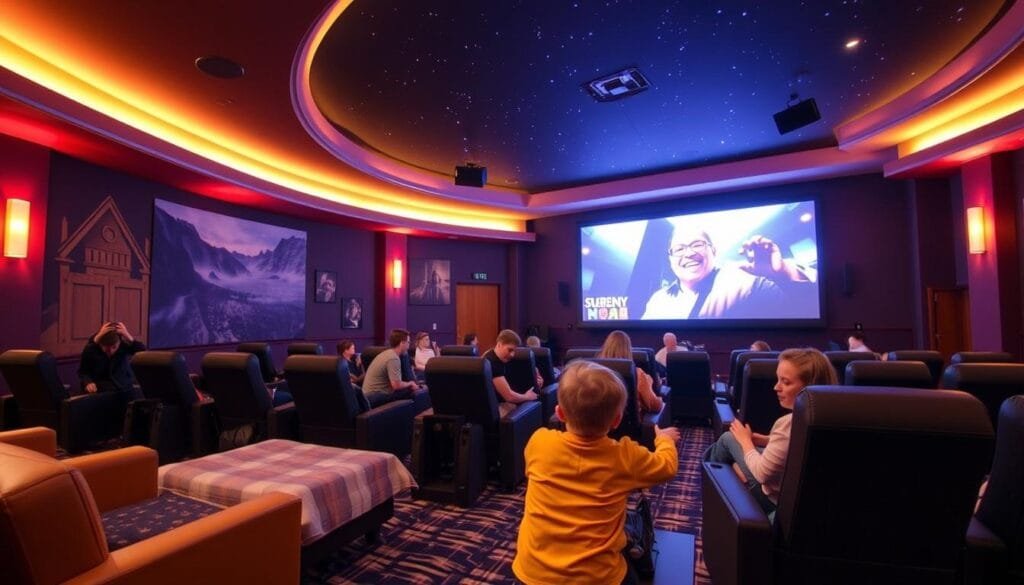Family trips are more popular now than ever before. The average number of travelers on a trip planned via The WOW List has more than doubled since 2019, growing from three to seven. This significant shift towards family travel indicates that more families are choosing to explore the world together, creating lifelong memories.
Successful family travel is about minimizing stress, smoothing out logistics, and keeping everyone in the family happy, from grandparents to teens and toddlers. With the right strategies, you can transform what might feel like “parenting somewhere else” into a genuinely refreshing and memorable experience for the entire family.
Key Takeaways
- Discover age-specific travel tips to navigate the unique challenges of traveling with infants, toddlers, elementary-age children, and teenagers.
- Learn how to balance sightseeing and activities with necessary downtime to avoid common pitfalls.
- Implement practical family travel hacks to ensure a smooth and enjoyable vacation.
- Understand the importance of planning and packing to minimize stress during your trip.
- Create lifelong memories by making the most of your family travel experience.
Why Family Travel Matters
When you travel with your family, you’re not just creating memories; you’re shaping the people your children will become. Family travel is an invaluable experience that exposes your kids to new cultures, languages, and environments, broadening their perspectives and understanding of the world.
Building Global Citizens
Traveling with your family helps children develop into global citizens. As Wendy noted, “Traveling gives your kids a confidence that will serve them well in life.” By meeting people from diverse backgrounds, kids learn empathy and adaptability, essential qualities for thriving in an increasingly interconnected world. Some key benefits include:
- Developing adaptability and resilience by navigating unfamiliar situations
- Gaining exposure to different cultures, fostering empathy and global awareness
- Learning history, geography, and social studies in real-world contexts
Creating Lifelong Memories
The experience of familytrips creates bonds and memories that last a lifetime. Brook’s family, for instance, has a hallway dedicated to photographs taken by her son, Zeke, during their travels, serving as a constant reminder of their adventures together. Such shared experiences not only bring families closer but also provide a wealth of stories to cherish for years to come, making travel a truly fun and enriching endeavor for all.
Smart Pre-Trip Planning Strategies
The key to a stress-free family vacation lies in thorough pre-trip planning. A well-organized trip not only reduces stress but also enhances the overall experience for everyone involved.
Involving Everyone in the Planning Process
Involving all family members in the planning process is crucial. By assigning age-appropriate responsibilities to children, such as researching activities or learning about the destination’s history, they feel invested in the trip. This not only builds excitement but also teaches them valuable skills. According to Zach Rabinor, who took an eight-month road trip to 13 countries with his family, involving everyone in the planning process helps to avoid missteps and gets everyone engaged and excited.
Scheduling Around Peak Times
Scheduling your trip during off-peak times can significantly reduce stress, crowds, and costs. Consider traveling during shoulder seasons or exploring less conventional destinations during popular travel periods. For instance, visiting Canada’s Maritime Provinces, including Newfoundland, can be a great way to escape summertime heat. Alternatively, Mexico’s Riviera Maya offers exciting opportunities like swimming with whale sharks.
Preparing Digital Entertainment
Preparing digital entertainment in advance is vital for a smooth trip. Downloading movies, games, books, and apps before departure ensures that you stay entertained, even without reliable airplane Wi-Fi. It’s also a good idea to create a shared digital folder with all travel documents, confirmations, and important information that all adult family members can access. This helps eliminate the stress of searching for critical details during the trip.

By implementing these smart pre-trip planning strategies, you can create a memorable and enjoyable family vacation. Effective planning, involving everyone in the process, and being prepared for the unexpected are key to a successful trip. With these tips, you’ll be well on your way to a stress-free and fun family adventure.
- Assign tasks to family members to build excitement and investment.
- Schedule trips during off-peak times to reduce stress and costs.
- Prepare digital entertainment to stay occupied during travel.
Choosing the Perfect Family Accommodations

Selecting the ideal family-friendly accommodations can significantly enhance your vacation experience. Your hotel choice is more than just a place to sleep; it’s the foundation of your entire family vacation. A well-chosen hotel can set the tone for a relaxing and enjoyable trip.
Why Your Hotel Choice Makes or Breaks Your Trip
Your accommodation choice is not just a place to rest; it’s the centerpiece of your family travel itinerary. A family-friendly hotel can cater to both children and adults, making travel enjoyable for all. When selecting a hotel, consider properties that offer amenities for both kids and grown-ups.
Space and Comfort Considerations
Space is crucial for family harmony. Look for room configurations that provide separation between sleeping areas, allowing parents to enjoy evening time without disturbing sleeping children. Consider hotels that offer spacious rooms or suites that can accommodate your family’s needs.
Amenities That Benefit the Whole Family
When choosing a hotel, prioritize amenities that benefit both children and adults. Pools, kid-friendly dining options, and spaces where parents can relax while keeping an eye on their children are essential. On-site dining options and concierge services can also greatly enhance your stay, reducing logistical challenges and making your vacation more enjoyable.
For longer stays, consider hotels with kitchen facilities or apartment-style setups that allow for meal preparation. This can save money and provide flexibility around mealtimes and snacks. Boutique hotels, with their personalized service and attention to detail, can also make families feel more comfortable and welcomed.
Top Family Travel Tips for a Smooth Vacation
To ensure a smooth family vacation, it’s essential to be prepared with the right tips and tricks. Family travel can be a wonderful experience, but it requires careful planning to avoid unnecessary stress. By focusing on key areas such as packing, transportation, and meal management, you can create a enjoyable trip for everyone.
Packing Essentials for Every Age Group
Packing strategically is crucial for a successful family trip. Create a comprehensive packing list organized by family member, paying special attention to age-specific needs. For infants, this includes diapers and formula, while teenagers might require entertainment for downtime. Always pack more essentials than you think you’ll need, especially for transportation days when delays are possible. A good rule of thumb is to have enough supplies to last 24 hours longer than your planned travel time.
Don’t forget to pack clothes, snacks, and drinks for yourself as well. It’s also wise to bring a few Ziploc bags or grocery bags to store wet or dirty clothing. Consider shipping bulky items like diapers or formula directly to your destination if you’re staying in one place for several days.
Transportation Hacks
Transportation can be a significant source of stress during family travel. Consider booking direct flights whenever possible to minimize the risk of meltdowns and missed connections. For road trips, plan stops every 2-3 hours at locations that allow children to burn energy, such as parks or rest areas with playgrounds.
Using these strategies can significantly reduce travel stress and make the journey more enjoyable for everyone. Remember to always carry a small “emergency kit” with basic medications, band-aids, wet wipes, and sanitizer, as well as a change of clothes for each child in your carry-on luggage.
Managing Meals and Snacks
Managing meals and snacks is crucial for preventing hunger-induced tantrums during travel. Pack a variety of shelf-stable, non-messy snacks that won’t melt or crumble easily in transit. Consider the dietary needs and preferences of your family members when selecting snacks.
Using packing cubes or Ziploc bags can help organize clothing and other essentials, making it easier to find what you need without unpacking everything. This is especially useful during multi-destination trips.
Age-Specific Travel Strategies: Infants and Toddlers
When planning a trip with young children, it’s essential to consider their unique needs to ensure a smooth journey. Traveling with infants and toddlers requires a thoughtful approach to cater to their needs and create lasting memories. Having a baby may change how you travel, but it doesn’t have to pause your adventures.
Essential Gear for Traveling with Babies
Traveling with infants and toddlers requires specific gear that balances convenience with necessity. Prioritizing lightweight, multi-functional items like travel strollers that fold compactly or car seats that convert to strollers can make a significant difference. For air travel, consider whether using a car seat on board or holding your child as a lap infant makes more sense for your situation.
Some essential items to consider include:
- Travel strollers
- Car seats that convert to strollers
- Baby carriers for easy navigation
- Portable changing pads
Sleep Solutions While Away from Home
Sleep solutions are critical when traveling with young children. Portable options like travel cribs, SlumberPods, or blackout curtains can help maintain sleep routines in unfamiliar environments. When booking accommodations, prioritize room configurations that allow for separate sleeping areas, such as suites or connecting rooms.

Managing Schedules and Routines
Maintaining some semblance of your child’s regular schedule, especially for naps and bedtime, can prevent overtired meltdowns. Plan activities around these crucial times rather than expecting your child to adapt completely. Consider babywearing through airports and at destinations to keep your hands free and provide comfort to your child.
| Age Group | Key Considerations | Tips |
|---|---|---|
| Infants (0-12 months) | Sleep schedules, feeding | Use baby carriers, prioritize sleep-friendly accommodations |
| Toddlers (1-3 years) | Nap times, potty training | Pack extra clothing, use portable potty seats |
By considering these age-specific travel strategies, you can create a more enjoyable and stress-free vacation for your family. For more travel tips and inspiration, visit https://bookmytrip.blog/.
Age-Specific Travel Strategies: Elementary Kids
Traveling with elementary-age kids demands a shift in strategy to keep them engaged. As children grow, their ability to participate in and enjoy travel experiences evolves, requiring parents to adapt their approach to ensure everyone has a great time.
Keeping Kids Engaged and Entertained
Elementary-age children benefit significantly from interactive and engaging travel experiences. Consider activities like cooking classes, wildlife encounters, or historical reenactments that make destinations come alive. National parks are also excellent venues, offering Junior Ranger programs that provide both educational activities and a sense of accomplishment. Incorporating technology, such as educational apps related to your destination, can also enhance the experience. Assigning age-appropriate responsibilities, like navigating with a map or keeping a travel journal, can build confidence and investment in the trip.
To keep kids engaged during potentially dull moments, such as waiting in lines or during transportation, create simple games or scavenger hunts related to your destination. Balancing structured activities with free play time is also crucial, allowing children to explore playgrounds or natural areas without strict schedules. Family-friendly tours led by guides who specialize in engaging children can be particularly effective.
Educational Opportunities on the Road
Traveling offers a wealth of educational opportunities for elementary-age kids. By incorporating learning into your travel plans, you can make the experience both fun and enriching. Consider visits to historical sites, science museums, or cultural landmarks that align with your child’s interests. Many destinations also offer workshops or classes designed for children, providing hands-on learning experiences. By leveraging these opportunities, you can create a travel experience that is both enjoyable and educational for your kids.
For more travel tips and inspiration, visit https://bookmytrip.blog/.
Age-Specific Travel Strategies: Tweens and Teens
Tweens and teens bring new dynamics to family trips, necessitating a shift in how you plan and execute your vacation. At this stage, kids are developing their own interests and desire more independence. To keep the peace and ensure everyone has a great time, consider accommodations that offer more space and privacy, such as connecting hotel rooms or vacation rentals with multiple bedrooms.
Giving Older Kids Independence and Input
Involving your tweens and teens in the trip planning process can significantly enhance their experience. Allow them to have input on the itinerary and even plan entire days of the vacation. This not only gives them a sense of ownership but also teaches valuable planning skills. Consider bringing along a friend for your tween or teen, especially on longer trips, as peer connections remain extremely important during these years.
Tech Balance and Social Connections
Establishing clear expectations about technology use is crucial before the trip begins. Balance screen time with family engagement by planning activities that appeal to their interests, such as adventure activities or photography opportunities. Look for destinations with teen-specific programs or spaces where they can meet peers and enjoy age-appropriate activities, enhancing their social connections while on family trips.
Creating a Balanced Itinerary
When planning a family trip, the key to a successful vacation lies in striking the right balance between activity and relaxation. A well-balanced itinerary ensures that you make the most of your family travel experience without feeling rushed or overwhelmed.
The Art of Slowing Down
Embracing the concept of slow travel can greatly enhance your family’s vacation experience. By slowing down, you give everyone the chance to relax and enjoy the destinations you visit. This approach allows for a more genuine connection with the places you visit and reduces the stress associated with a packed schedule.
Consider allocating time for leisurely activities and spontaneous exploration. In 2025, families are encouraged to adopt this mindset to make the most of their trips.
Scheduling Downtime
Incorporating downtime into your daily schedule is crucial, especially during the afternoon when energy levels tend to wane. Activities such as pool time, quiet reading, or simply relaxing at your accommodations can help recharge everyone’s batteries.
Building downtime into your itinerary ensures that you have a chance to rest and enjoy each other’s company. Aim to have at least one completely unplanned day for every 4-5 days of your trip.
Flexibility is Your Friend
Being flexible is an essential travel skill, especially when traveling with family. Unexpected events such as weather changes or sudden illness can derail even the most carefully planned itinerary. Maintaining a positive attitude about plan adjustments is key.
For visits to national park or other nature-based destinations, allow extra time for spontaneous exploration and enjoying scenic vistas. This flexibility will help create a more enjoyable and stress-free experience for everyone.
| Activity | Recommended Time | Benefits |
|---|---|---|
| Morning Activity | 9:00 AM – 12:00 PM | Engages kids, sets a positive tone for the day |
| Downtime | 1:00 PM – 3:00 PM | Recharges energy, promotes relaxation |
| Flexible Time | 3:00 PM – 5:00 PM | Allows for spontaneity, adjusts to family’s needs |
Conclusion: Making Family Travel Truly Enjoyable
By adopting a flexible approach to family travel, you can turn what might seem like a chaotic experience into a truly magical journey. With thoughtful planning and realistic expectations, you can create a vacation that is enjoyable for everyone. This involves choosing destinations that excite all family members and planning for a balance of activity and downtime.
Remember, the goal of family vacations is to create lasting memories and strengthen bonds. By implementing the strategies outlined in this guide, you can transform potentially stressful trips into meaningful breaks from everyday life. As you plan your next vacation, focus on making moments that will be cherished by your family for years to come.
FAQ
How do I choose the best destination for my family vacation?
Consider the age and interests of your children when selecting a destination. National parks, beaches, and cities with kid-friendly attractions are often great options. You can also involve your kids in the planning process to ensure everyone is excited about the trip.
What are some essential items to pack when traveling with kids?
Packing essentials include clothing, diapers, formula, and any necessary medications. You should also consider bringing digital entertainment such as tablets or portable DVD players, as well as snacks and refillable water bottles.
How can I keep my kids entertained during long road trips or flights?
Bringing along games, coloring books, and digital entertainment can help keep kids occupied. You can also plan regular breaks during road trips to stretch your legs and get some fresh air.
What are some strategies for managing meal times while traveling with kids?
Consider packing snacks and sandwiches, or researching kid-friendly restaurants at your destination. You can also look into accommodations that offer kitchen facilities, allowing you to prepare some meals yourself.
How can I ensure my hotel room is safe and comfortable for my family?
When booking a hotel, look for rooms with separate living areas or adjoining rooms to provide extra space. You should also check that the hotel has amenities such as cribs or rollaway beds available if needed, and that the room is equipped with safety features such as outlet covers.
What are some tips for balancing structured activities with downtime on family vacations?
Create a flexible itinerary that allows for spontaneity and relaxation. Be sure to schedule in some downtime each day, whether that’s lounging by the pool or taking a leisurely stroll around your destination.
How can I involve my older kids in the planning process to make the vacation more enjoyable for them?
Ask your older kids to help research activities and attractions at your destination, and incorporate their suggestions into your itinerary. You can also give them some independence by allowing them to explore certain areas on their own, with some guidance and supervision.